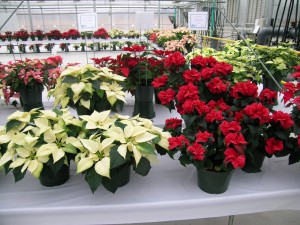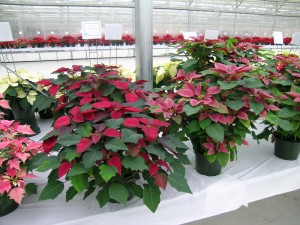Poinsettias, Amaryllis and Paperwhites, Oh My!
I love to grow things. In fact, I will try growing almost anything once. Indoors, outdoors, elegant, clunky, thorny – every plant has its virtues. I even accepted (against my better judgment) a Crown of Thorns plant (Euphorbia Milii) from my friend and fellow writer, Willem Lange. It was, I believe, a plant from his grandmother – and Will is older than I am. So it might be a 100-year old house plant. It does have nice small reddish flowers (it blooms constantly), but it is tall and lanky and covered with dangerous thorns. I keep it on the deck in the summer where leaves and pine needles fall on it – but I’m afraid to go into the interior regions of this plant to clean them up now, as I might need a blood transfusion after doing the job.
I recently purchased an amaryllis kit at my favorite general store. Amaryllis plants are wonderful: they will produce anywhere from 3 to 9 lovely large lily-like blossoms. They are foolproof if you follow the directions. They come with a soil-like medium, a pot and the bulb. Just hydrate the disk of planting medium (generally coir, a sustainable alternative to peat moss made of shredded coconut fiber) and plant the amaryllis bulb. Half or more of the bulb should be above the soil line in the pot. I like to soak the roots in warm water for 15 minutes before planting to make them more flexible, though the directions don’t tell you to do that. Put on a sunny windowsill and wait. Sometimes an amaryllis bulb will start growing immediately, other times it will sit and sulk for up to a month. (You might want to talk to it, giving it encouraging words if you’re in a hurry). Sometimes it will produce leaves, then flowers – but most commonly the flowers come first. Sometimes you will get just one stalk of flowers, other times 2 or even 3 in sequence. The more you pay for the bulb, generally, the more stems you will get.
Even easier than amaryllis are poinsettias. Every florist and grocery store has them for sale in full bloom right now, ready to adorn your table. Only the “flowers” are not really flowers. They are modified leaves called bracts, which surround an inconspicuous yellow flower in the middle of each cluster. You can get them in a wide variety of colors and shapes. Red is the classic color, and still my favorite, but they also come in pink, cream, striped, peach, cinnamon and more. The key to happy poinsettias is to avoid overwatering them. Only water when the soil feels dry – and when the pot feels light when you pick it up. They do fine in the interior of the house – they don’t need direct sunlight, which may account, in part, for their popularity. You can save them from year to year but the production of the colorful bracts depends on having days of a certain length, which is best done in a greenhouse. And contrary to popular myth, the plants are not poisonous to cats – a University of Ohio team tested them. Poor test kitties, I’m sure they’re not tasty. (I do wonder how they got the cats to eat the poinsettias).
Paperwhite are another sure winner for the holidays, and a great gift for the gardener. These are generally sold as bulbs, not kits, so you have a little more work to do if you’d like these fragrant white blossoms. And it’s too late to get them blooming by Christmas. They generally take a month or more from planting to blooming (for me, anyway). But I shall buy some today, and get started. Paperwhites are in the narcissus or daffodil family. To get them to bloom you will need a flat, wide dish that is an inch or two deep. Fill the dish with gravel or small stones. And although you can pick stones out of your driveway, white stones are available at garden centers in small bags and look much nicer. Simply arrange the bulbs shoulder-to shoulder in the gravel with at least half the bulb sticking up above the layer stones. Then add water until it just kisses the bottom of the bulbs. Do not, I repeat, do not fill the dish with too much water, as you can rot the bulbs. You may need to tie up your paperwhites to keep them from flopping over when the leaves and flower stems get tall. And rotating the dish every few days keeps them from leaning toward the window grasping for more winter light. Paperwhites produce more than one blossom on each stem, and are really quite elegant. They are not re-useable, however. That’s right. After they bloom just throw them away because they are not hardy in New England.
Winter in New England can be bleak. I buy cut flowers at my local florist to keep on the table to brighten the room and remind me of summer. But a few good plants can tide me over during those times when the flowers I’ve bought have gone by, and before I get the next batch. And as to that Crown of Thorns, writing this column inspired me to work on cleaning it up. I used the vacuum cleaner and it worked!
Visit www.henry.homeyer.com to read about Henry’s new children’s book, Wobar and the Quest for the Magic Calumet. It is a fantasy-adventure chapter book about a boy and a cougar.





